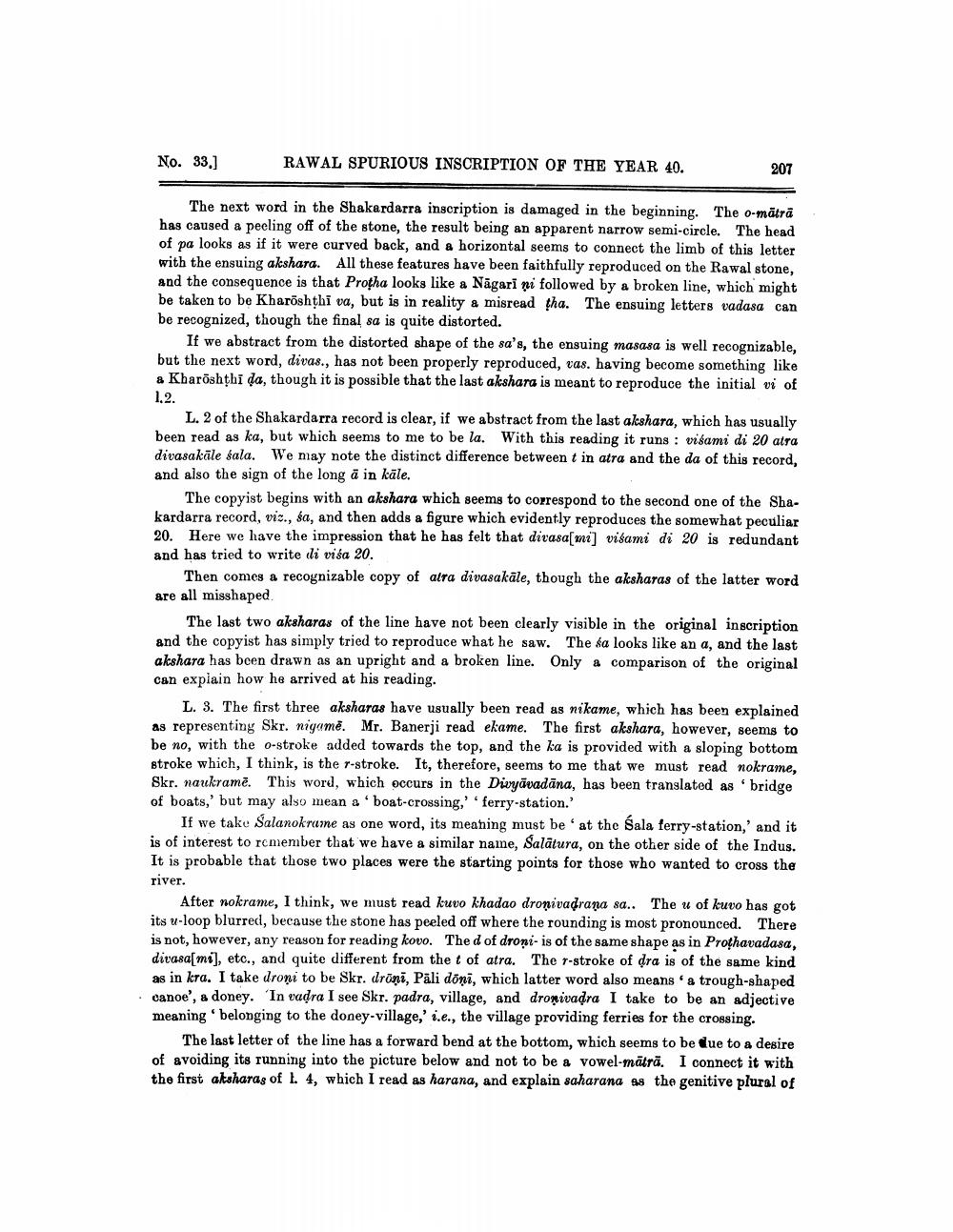________________
No. 33.]
RAWAL SPURIOUS INSCRIPTION OF THE YEAR 40.
207
The next word in the Shakerdarra inscription is damaged in the beginning. The o-mātrā has caused a peeling off of the stone, the result being an apparent narrow semi-circle. The head of pa looks as if it were curved back, and a horizontal seems to connect the limb of this letter with the ensuing akshara. All these features have been faithfully reproduced on the Rawal stone, and the consequence is that Progha looks like a Nagari ni followed by a broken line, which might be taken to be Kharöshthi va, but is in reality & misread tha. The ensuing letters vadasa can be recognized, though the final sa is quite distorted.
If we abstract from the distorted shape of the sa's, the ensuing masasa is well recognizable, but the next word, divas., has not been properly reproduced, vas. having become something like & Kharöshthi da, though it is possible that the last akshara is meant to reproduce the initial vi of 1.2.
L. 2 of the Shakardarra record is clear, if we abstract from the last akshara, which has usually been read as ka, but which seems to me to be la. With this reading it runs: visami di 20 atra dirasakāle sala. We may note the distinct difference between t in atra and the da of this record, and also the sign of the long å in käle.
The copyist begins with an akshara which seems to correspond to the second one of the Shakardarra record, viz., śa, and then adds a figure which evidently reproduces the somewhat peculiar 20. Here we have the impression that he has felt that dirasa[m2] visami di 20 is redundant and has tried to write di viếa 20.
Then comes a recognizable copy of alta divasakāle, though the aksharas of the latter word are all misshaped
The last two aksharas of the line have not been clearly visible in the original inscription and the copyist has simply tried to reproduce what he saw. The ka looks like an a, and the last akshara has been drawn as an upright and a broken line. Only a comparison of the original can explain how he arrived at his reading.
L. 3. The first three aksharas have usually been read as nikame, which has been explained as representing Skr. nigamē. Mr. Banerji read ekame. The first akshara, however, seems to be no, with the o-stroke added towards the top, and the ka is provided with a sloping bottom stroke which, I think, is the T-stroke. It, therefore, seems to me that we must read nokrame, Skr. naukramë. This word, which occurs in the Divyāvadāna, has been translated as bridge of boats,' but may also mean a boat-crossing,' ' ferry-station.'
If we take Salanokrane as one word, its meaning must be at the Sala ferry-station,' and it is of interest to remember that we have a similar name, Salātura, on the other side of the Indus. It is probable that those two places were the starting points for those who wanted to cross the river.
After nokrame, I think, we must read kuvo khadao dronivadrana sa.. The u of kuvo has got its u-loop blurred, because the stone has peeled off where the rounding is most pronounced. There is not, however, any reason for reading kovo. The d of droni-is of the same shape as in Prothavadasa, divasa[mi], etc., and quite different from the t of atra. The r-stroke of dra is of the same kind as in kra. I take droni to be Skr. drüni, Pāli doni, which latter word also means a trough-shaped canoe', a doney. 'In eadra I see Skr. padra, village, and dronivadra I take to be an adjective meaning belonging to the doney-village,' i.e., the village providing ferries for the crossing.
The last letter of the line has a forward bend at the bottom, which seems to be due to a desire of avoiding its running into the picture below and not to be a vowel mäträ. I connect it with the first aksharas of I. 4, which I read as harana, and explain saharana ss the genitive plural of




